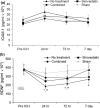Simvastatin-Ezetimibe enhances growth factor expression and attenuates neuron loss in the hippocampus in a model of intracerebral hemorrhage
- PMID: 33278834
- PMCID: PMC8451876
- DOI: 10.1111/fcp.12635
Simvastatin-Ezetimibe enhances growth factor expression and attenuates neuron loss in the hippocampus in a model of intracerebral hemorrhage
Abstract
Intracerebral hemorrhage (ICH) is a common and severe neurological disorder associated with high morbidity and mortality rates. Despite extensive research into its pathology, there are no clinically approved neuroprotective treatments for ICH. Increasing evidence has revealed that inflammatory responses mediate the pathophysiological processes of brain injury following ICH. Experimental ICH was induced by direct infusion of 100 μL fresh (non-heparinized) autologous whole blood into the right basal ganglia of Sprague-Dawley rats at a constant rate (10 μL/min). The simvastatin group was administered simvastatin (15 mg/kg) and the combination therapy group was administered simvastatin (10 mg/kg) and ezetimibe (10 mg/kg). Magnetic resonance imaging (MRI), the forelimb use asymmetry test, the Morris water maze test, and two biomarkers were used to evaluate the effect of simvastatin and combination therapy. MRI imaging revealed that combination therapy resulted in significantly reduced perihematomal edema. Biomarker analyses revealed that both treatments led to significantly reduced endothelial inflammatory responses. The forelimb use asymmetry test revealed that both treatment groups had significantly improved neurological outcomes. The Morris water maze test revealed improved neurological function after combined therapy, which also led to less neuronal loss in the hippocampal CA1 region. In conclusion, simvastatin-ezetimibe combination therapy can improve neurological function, attenuate the endothelial inflammatory response and lead to less neuronal loss in the hippocampal CA1 region in a rat model of ICH.
Keywords: hippocampus; intracerebral hemorrhage; neurological outcome; perihematomal edema; simvastatin; simvastatin-ezetimibe.
© 2020 The Authors. Fundamental & Clinical Pharmacology published by John Wiley & Sons Ltd on behalf of Société Française de Pharmacologie et de Thérapeutique.
Conflict of interest statement
The authors declare no conflict of interest.
Figures






Similar articles
-
Simvastatin and Simvastatin-Ezetimibe Improve the Neurological Function and Attenuate the Endothelial Inflammatory Response after Spinal Cord Injury in Rat.Ann Clin Lab Sci. 2019 Jan;49(1):105-111. Ann Clin Lab Sci. 2019. PMID: 30814085
-
Enhanced neuroprotective effects of co-administration of G-CSF with simvastatin on intracerebral hemorrhage in rats.Turk Neurosurg. 2012;22(6):732-9. doi: 10.5137/1019-5149.JTN.6177-12.1. Turk Neurosurg. 2012. PMID: 23208905
-
Simvastatin and atorvastatin improve neurological outcome after experimental intracerebral hemorrhage.Stroke. 2009 Oct;40(10):3384-9. doi: 10.1161/STROKEAHA.108.544395. Epub 2009 Jul 30. Stroke. 2009. PMID: 19644071 Free PMC article.
-
White matter repair and treatment strategy after intracerebral hemorrhage.CNS Neurosci Ther. 2019 Oct;25(10):1113-1125. doi: 10.1111/cns.13226. Epub 2019 Oct 2. CNS Neurosci Ther. 2019. PMID: 31578825 Free PMC article. Review.
-
Translational Intracerebral Hemorrhage Research: Has Current Neuroprotection Research ARRIVEd at a Standard for Experimental Design and Reporting?Transl Stroke Res. 2020 Dec;11(6):1203-1213. doi: 10.1007/s12975-020-00824-x. Epub 2020 Jun 5. Transl Stroke Res. 2020. PMID: 32504197 Free PMC article.
Cited by
-
Blood-Spinal Cord Barrier: Its Role in Spinal Disorders and Emerging Therapeutic Strategies.NeuroSci. 2021 Dec 21;3(1):1-27. doi: 10.3390/neurosci3010001. eCollection 2022 Mar. NeuroSci. 2021. PMID: 39484675 Free PMC article. Review.
-
Research progress of endogenous hematoma absorption after intracerebral hemorrhage.Front Neurol. 2023 Mar 10;14:1115726. doi: 10.3389/fneur.2023.1115726. eCollection 2023. Front Neurol. 2023. PMID: 36970539 Free PMC article. Review.
-
Resolvin D1 combined with exercise rehabilitation alleviates neurological injury in mice with intracranial hemorrhage via the BDNF/TrkB/PI3K/AKT pathway.Sci Rep. 2024 Dec 28;14(1):31447. doi: 10.1038/s41598-024-83019-w. Sci Rep. 2024. PMID: 39733073 Free PMC article.
References
-
- Cannon J.R., Xi G., Keep R.F.Recent research on changes in genomic regulation and protein expression in intracerebral haemorrhage. Int. J. Stroke (2007) 2 265–269. - PubMed
-
- Chen J., Zhang Z.G., Li Y. et al. Statins induce angiogenesis, neurogenesis, and synaptogenesis after stroke. Ann. Neurol. (2003) 53 743–751. - PubMed
-
- Zhang L., Zhang Z.G., Ding G.L. et al. Multitargeted effects of statin‐enhanced thrombolytic therapy for stroke with recombinant human tissue‐type plasminogen activator in the rat. Circulation (2005) 112 3486–3494. - PubMed
-
- Lu D., Mahmood A., Qu C., Goussev A., Lu M., Chopp M.Atorvastatin reduction of intracranial hematoma volume in rats subjected to controlled cortical impact. J. Neurosurg. (2004) 101 822–825. - PubMed
MeSH terms
Substances
Grants and funding
LinkOut - more resources
Full Text Sources
Other Literature Sources
Medical
Miscellaneous

